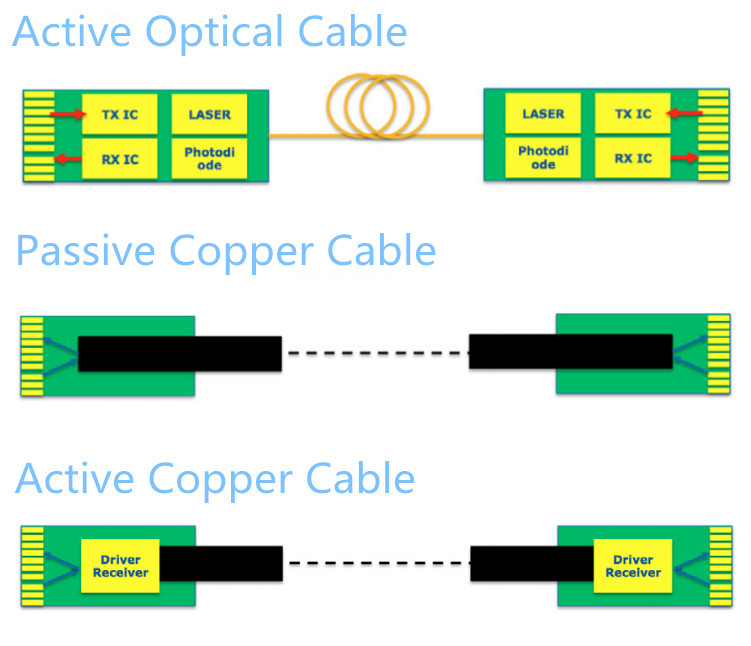May 05, 2016
Gradually, 1G and 10G data rates are becoming not adequate enough to meet the high-bandwidth application needs. 40G Ethernet provides a good solution and plays an important role for the transition from 10G Ethernet to 100G Ethernet. It has been a very preferable option now. Products for 40G Ethernet such as 40G QSFP+ transceivers, 40G QSFP+ direct attach copper (DAC) cables and active optical cables (AOCs) are very popular in the market. 40G QSFP+ DACs and QSFP+ AOCs are cost-effective alternative solutions in short reach interconnections. In this post, a detailed introduction to 40G QSFP+ DACs and QSFP+ AOCs will be given.
40G QSFP+ DACs and QSFP+ AOCs are two kinds of optical transceiver assemblies, which are terminated with transceiver-style plugs to be used in the same ports where optical transceivers are used. QSFP+ AOCs, such as Cisco QSFP-H40G-AOC1M compatible 40G QSFP+ AOC, are active devices, which incorporate active electrical and optical components to boost/receive signal via optical fiber. QSFP+ DACs can be both passive and active. Passive DACs (often called PCCs), such as Cisco QSFP-4SFP10G-CU3M compatible 40G QSFP+ to 4x10G SFP+ passive DAC, have no active circuitry, which means there is a direct connection between copper cable and QSFP+ transceiver's printed circuit board (PCB) electrical contacts. Active DACs (often called ACCs) incorporate active component to boost/receive signal via copper cable. The following picture shows the general internal structure of AOCs and DACs.

QSFP+ DACs and QSFP+ AOCs are ideal solutions for short-distance interconnection, and they are widely used in data centers. This part will talk about advantages and disadvantages of QSFP+ DACs and QSFP+ AOCs respectively.
QSFP+ DACsNowadays people may think that copper technology is out of fashion compared to fiber technology. It is not true for QSFP+ DAC cables. QSFP+ DACs still get their roles in the market for the following advantages.
- Interchangeability—QSFP+ DACs are interchangeable and hot swappable with fiber optic modules.
- Enough data rate for various applications—QSFP+ DAC cables can support higher data rates than traditional copper interfaces. QSFP+ DAC cables offer a cost-effective way to establish a 40G link between QSFP+ ports of QSFP+ switches within racks and across adjacent racks.
- Low cost—Copper cables are much cheaper than fiber cables, which makes QSFP+ DACs a cost-effective solution for short reach applications.
The defect of QSFP+ DACs is that they are heavy and bulky, making them difficult to be managed. Furthermore, due to the nature of electrical signals, DAC cables are vulnerable to the effects of electromagnetic interference (EMI), such as undesirable responses, degradation, or complete system failure.
QSFP+ AOCsOffering reliable transport for aggregated data rates up to 40 Gbps, QSFP+ AOCs provide customers with flexibility of traditional optical modules by interfacing to systems via a standard QSFP MSA connector. QSFP+ AOCs are premium products, offering several benefits, as shown below.
- Great bandwidth—QSFP+ AOCs have a throughput of up to 40 Gbps with QSFP+ transceivers. They are ideal for the high density signal transmission in most data centers and high performance computing applications.
- EMI immunity—Optical fiber is a kind of dielectric (not able to conduct electric current), QSFP+ AOCs are immune to electromagnetic energy.
- Light weight—Fiber cables are lighter than copper cables. QSFP+ AOC weighs less than a comparable DAC cable.
Compared with QSFP+ DAC cables, the drawback of QSFP+ AOCs is that they may be a little more expensive for customers.
40G QSFP+ DACs and QSFP+ AOCs use the same port as an optical transceiver but provide you with significant cost and power savings in short reach applications. They can fill the need for short, cost-effective connectivity and provide a power-efficient and cost-effective replacement to 40G optical transceivers. Fiberstore offers you a large range of QSFP+ DACs and QSFP+ AOCs with high quality for your 40G applications.
Posted by: jowang at
06:47 AM
| No Comments
| Add Comment
Post contains 646 words, total size 5 kb.
35 queries taking 0.0184 seconds, 70 records returned.
Powered by Minx 1.1.6c-pink.









